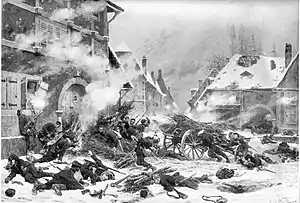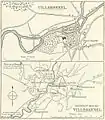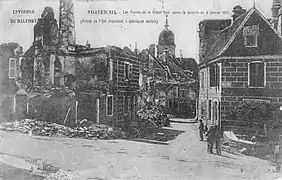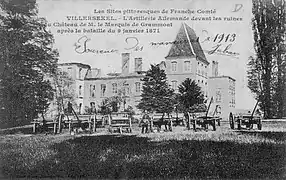Battle of Villersexel
The Battle of Villersexel took place on 9 January 1871 as part of the Franco-Prussian War. Elements of the French Armée de l'Est under General Bourbaki engaged August von Werder's Prussian forces. It resulted in a French victory.
| Battle of Villersexel | |||||||
|---|---|---|---|---|---|---|---|
 La bataille de Villersexel by Alphonse de Neuville (1834-1885). | |||||||
| |||||||
| Belligerents | |||||||
|
|
| ||||||
| Commanders and leaders | |||||||
|
|
| ||||||
| Strength | |||||||
| 15,000 | 20,000 | ||||||
| Casualties and losses | |||||||
|
578 438 dead or wounded, 140 captured |
1,354 654 dead or wounded, 700 captured | ||||||
Background
In the turmoil and confusion following major reverses and capitulations at Sedan, Paris, and Metz, the remaining French armies faced major supply difficulties which restricted their movements. The Armée de l'Est was tasked with reaching and assisting Belfort, where Colonel Denfert-Rochereau still held out.
Battle
Werder's Prussians caught up to Bourbaki in the evening of 9 January at Villersexel, where a French detachment had taken positions the evening before. Prussian troops, filing through an unguarded pass, rapidly overwhelmed the positions surrounding the bridge over the Ognon. By 13:00h the château fell to the Prussians. However, the French lines at Esprels, Autrey-le-Vay, and, to the east, Villers-la-Ville, successfully checked the Prussian attack.
A French counterattack organized by Bourbaki pressed steadily forth in the afternoon and recaptured the château after confused street fighting. Fighting continued into the night until the retreat of the Prussians at 3:00am. Bourbaki continued his march on 13 January, while Werder fell back some 20 kilometers north along the Lisaine.
Results of the Battle
Though the French sustained more losses they managed to drive the Prussian armies from their barricades.
The Chateau des Villersexel, then known as Château des Grammont, was destroyed during the battle. The Château was later rebuilt. The village, also burned, was particularly affected in its lower part to Ognon.
 A map of the area around Villersexel at the time of the battle
A map of the area around Villersexel at the time of the battle View of destruction to the village
View of destruction to the village Artillery placements at the ruins of the Château
Artillery placements at the ruins of the Château View of destruction in the lower portion of the village
View of destruction in the lower portion of the village
References
- Colonel Rousset, Histoire générale de la Guerre franco-allemande, Vol. 2, édition Jules Tallandier, Paris, 1911.
- Général Pierre Bertin, " 1870-1871 Désillusions dans l'Est" Cêtre Besançon Editions, 2007.